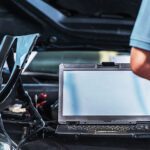Automotive SerDes Taps Ethernet for High-Speed Communications
The first wave of devices based on the Automotive SerDes Alliance Motion Link Ethernet (ASA-MLE) draft specification are coming out now. These devices will become components of critical infrastructure for the next generation of intelligent Software Defined Vehicles.

A new automotive SerDes technology standard is rapidly coming into view: the Automotive SerDes Alliance Motion Link Ethernet (ASA-MLE) draft specification, ASA-ML 2.0, will be finalized this year. Compliant products, including Ethernet PHYs, switches, CSI-2 bridge ICs, and zonal aggregators, are already on the market or coming soon with contributions from ASA members Amphenol Communications Solutions, BizLink, JAE, Molex, Rosenberger, TE Connectivity, and Würth Elektronik.
The Automotive SerDes Alliance (ASA) was established in 2019 by BMW, Continental, Broadcom, Fraunhofer IIS, and NXP to address the high-bandwidth and low-latency networking requirements in vehicles equipped with advanced driver-assistance systems (ADAS). As artificial intelligence and smart city integrations become a greater part of automotive design, the group’s scope has expanded to coordinate data across various vehicle systems and zones with an emphasis on high speeds, energy efficiency, and data security in connected car architectures. Member companies of the alliance cover the entire automotive ecosystem, including car manufacturers, tier-one component suppliers, semiconductor companies, and interconnect suppliers.
While SerDes technology has been used in cars for more than 20 years, alongside standards such as MIPI CSI-2, DisplayPort, and HDMI for separate applications, ASA focuses on interoperability, asymmetrical data transmission, centralized and zonal architectures, and the needs of next-generation intelligent vehicles. In December 2020, ASA released the ASA Motion Link transceiver specification v1.01, which defines a SerDes communication technology for in-vehicle connections. ASA-MLE enables asymmetrical Ethernet communication, which optimizes data transmission by allowing different data rates in each direction. This is particularly beneficial for applications such as video streaming and control signals, where the data requirements differ between the sending and receiving nodes. ASA-MLE’s supports for zonal architectures reduce the complexity, weight, and cost of vehicle wiring harnesses by centralizing the compute resources and distributing data more efficiently across the vehicle. It also provides multi-gigabit-per-second data rates, essential to the high bandwidth needs of advanced driver-assistance systems (ADAS) and artificial intelligence (AI) in vehicles, with ultra-low latency, which is critical for real-time data processing and decision-making.

TE Connectivity’s (TE) MATE-AX miniaturized automotive coaxial connector system provides advanced automotive data transmission performance, supporting up to 9 GHz. The MATE-AX system features a wide range of connector types and sizes. MATE-AX terminals can support up to 75% reduction in PCB footprint and by using existing wire types, it enables flexible integration into existing coaxial architecture. AVIVA designed TE’s MATE-AX into its ASA-compliant Quad Port device.
“The automotive industry is experiencing a transformation of vehicle and business models moving from traditional vehicles, with features and functionality defined at point-of-sale, to autonomous and connected software-defined vehicles offering a safer, more connected and personalized mobility experience that is defined, on-demand, by software,” said Bert Bergner, Fellow R&D Engineer, Data Connectivity at TE. “With these developments, comes the increasing need for data to travel further and at faster speeds.” To meet this challenge, TE collaborated with AVIVA to develop a reliable connectivity solution that follows the ASA specification. The new solution uses AVIVA’s Quad Port device, the industry’s first ASA-based chipset with an aggregate throughput of approximately 64 Gb/s with up to 16 Gb/s line rate per port, as well as TE’s coaxial MATE-AX connector portfolio of smart, integrated, and multi-hybrid connector and cable assemblies. The solution can support both shielded twisted pair (STP) as well as coaxial cables.
Learn more about automotive SerDes at ASA. Visit the enhanced Preferred Suppliers pages for the interconnect suppliers who are members of the alliance: Amphenol Communications Solutions, BizLink, JAE, Molex, Rosenberger, TE Connectivity, and Würth Electronik.
Like this article? Check out our other articles on Connected Vehicles and New Technology, our Automotive Market Page, and our 2024 Article Archive.
Subscribe to our weekly e-newsletters, follow us on LinkedIn, Twitter, and Facebook, and check out our eBook archives for more applicable, expert-informed connectivity content.
- Fighting e-Waste with New Greener Materials for Interconnects - June 18, 2024
- Intelligent LEDs Help Farmers Grow Superfoods - June 11, 2024
- What are Push-Pull Circular Connectors? - June 11, 2024





